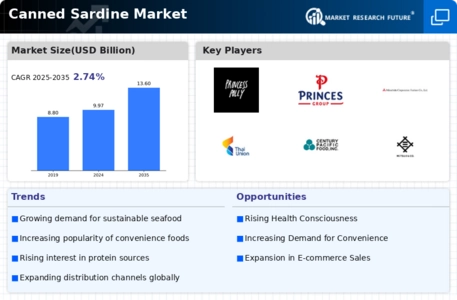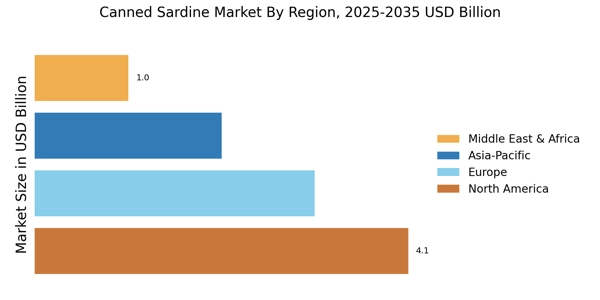E-commerce Growth and Online Retailing
The Canned Sardine Market is significantly impacted by the growth of e-commerce and online retailing. With the rise of digital shopping platforms, consumers are increasingly purchasing canned goods online, including sardines. This shift is driven by the convenience of online shopping and the ability to access a wider range of products. Recent statistics reveal that online grocery sales have surged, with a projected growth rate of 20% annually. This trend presents an opportunity for canned sardine manufacturers to expand their distribution channels and reach a broader audience. Additionally, online platforms allow for targeted marketing strategies, enabling brands to engage with consumers more effectively. As e-commerce continues to evolve, the canned sardine market is likely to benefit from enhanced visibility and accessibility.
Nutritional Awareness and Health Trends
The Canned Sardine Market is benefiting from a surge in nutritional awareness among consumers. With an increasing focus on health and wellness, individuals are more inclined to choose foods that offer health benefits. Sardines are rich in omega-3 fatty acids, protein, and essential vitamins, making them a desirable option for health-conscious consumers. Recent surveys indicate that nearly 60% of consumers prioritize nutritional content when selecting food products. This trend is particularly pronounced among younger demographics, who are more likely to seek out foods that align with their health goals. Consequently, the canned sardine segment is poised for growth as it aligns with these health trends, prompting manufacturers to highlight the nutritional advantages of their products in marketing efforts.
Rising Demand for Convenient Food Options
The Canned Sardine Market is experiencing a notable increase in demand for convenient food options. As lifestyles become busier, consumers are seeking quick and easy meal solutions. Canned sardines, being ready-to-eat and requiring minimal preparation, fit perfectly into this trend. According to recent data, the convenience food sector has seen a growth rate of approximately 4% annually, which positively influences the canned sardine segment. This shift towards convenience is particularly evident among urban populations, where time constraints often dictate food choices. Furthermore, the portability of canned sardines makes them an attractive option for on-the-go meals, thereby expanding their market reach. As a result, manufacturers are likely to focus on enhancing packaging and product variety to cater to this growing consumer preference.
Sustainability and Eco-Friendly Practices
The Canned Sardine Market is increasingly influenced by sustainability and eco-friendly practices. As consumers become more environmentally conscious, there is a growing demand for products that are sourced sustainably. Canned sardines, often harvested from well-managed fisheries, appeal to this demographic. Reports suggest that sustainable seafood consumption has risen by over 20% in recent years, indicating a shift in consumer preferences. This trend compels manufacturers to adopt sustainable sourcing practices and transparent labeling, which can enhance brand loyalty. Additionally, the use of recyclable packaging is becoming a standard expectation among consumers, further driving the need for innovation in the canned sardine sector. As sustainability becomes a key purchasing criterion, companies that prioritize eco-friendly practices are likely to gain a competitive edge in the market.
Flavor Innovation and Product Diversification
The Canned Sardine Market is witnessing a wave of flavor innovation and product diversification. As consumer palates evolve, there is a growing appetite for unique and diverse flavor profiles. Manufacturers are responding by introducing a variety of canned sardine products infused with different spices, sauces, and marinades. This trend not only caters to adventurous eaters but also helps to attract a broader audience. Data indicates that flavored canned seafood products have seen a sales increase of approximately 15% over the past year. This innovation allows brands to differentiate themselves in a crowded market, appealing to both traditional consumers and those seeking novel culinary experiences. As a result, the emphasis on flavor innovation is likely to continue shaping the canned sardine market landscape.


















Leave a Comment